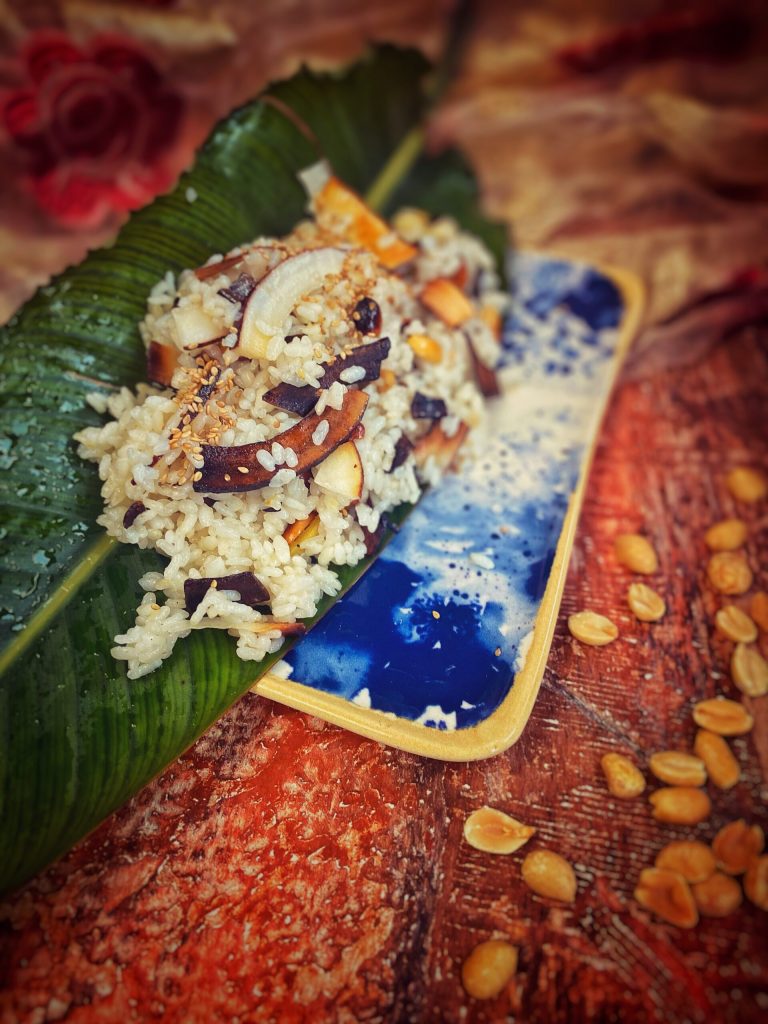Htamane (ထမနှေ့) is a traditional Burmese savory dish mainly composed of a mixture of glutinous rice, fried coconut flakes, roasted peanuts, roasted sesame, peanut oil, and ginger.
It is a ceremonial dish served on the full moon day of Tabodwe (တေပိှဳ့) as part of the harvest festival that takes place around the eleventh month of the Burmese calendar to celebrate the end of winter.
During this period, htamane ceremonies and contests are held across the country as entertainment.
Traditionally, three men are involved in the preparation. Two men mix with large wooden spatulas while the third instructs how to mix the dough.
At the end, fried coconut pieces, roasted sesame, roasted peanuts, peanut oil, and fried ginger are added to the pot, mixing with the dough.
Htamane is served on banana leaves that have been rubbed with oil.
Huge portions of htamane are prepared for the community; part of it is offered in temples to the Buddha, and the rest is given to friends and family as a harvest festival gift.

Ingredients
- 10.5 oz glutinous rice
- 1.75 oz coconut flakes
- 1.75 oz peanuts
- to taste fresh ginger
- 1.25 cups water
- to taste sesame seeds
- to taste peanut oil
Tools
- 1 Wok
Steps
Soak the rice for at least 2 hours.
Fry the coconut flakes in peanut oil.
Roast the peanuts and sesame seeds.
In a wok, fry the garlic and ginger in peanut oil for a few minutes.
Remove garlic and ginger, add drained and rinsed rice, add salt and water.
Cover and cook for about 15/20 minutes, stirring occasionally.
Add the peanuts and coconut, mixing with spatulas.
Serve on a banana leaf decorating with roasted sesame seeds.

FAQ (Questions and Answers)
How is the Burmese calendar structured?
The Burmese calendar consists of twelve months and twelve corresponding festivals.
Most of the festivals are related to Buddhism, and in any city or village, the festival held at the pagoda (paya pwè) is the most important.
It is a lunisolar calendar in which months are based on lunar months and years are based on sidereal years.
Primarily based on an older version of the Hindu calendar, although unlike the Indian systems, it employs a version of the Metonic cycle; it must therefore reconcile the sidereal years of the Hindu calendar with the nearly tropical years of the Metonic cycle by adding intercalary months and days at irregular intervals.
The most important festival is called Thingyan, a four-day event celebrating the arrival of the lunar new year, held on the first day of Tagu (the name of the first month in the Burmese calendar), around mid-April.
Like the New Year’s celebrations in other Southeast Asian countries (such as the Thai Songkran), people splash water on one another.
Nonetheless, Thingyan holds a specific religious significance, as on those days, Buddhist faithful are to observe the eight precepts.

